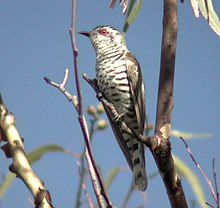Little bronze cuckoo
| Little bronze cuckoo | ||||||||||
|---|---|---|---|---|---|---|---|---|---|---|

Little bronze cuckoo ( Chrysococcyx minutillus ) |
||||||||||
| Systematics | ||||||||||
|
||||||||||
| Scientific name | ||||||||||
| Chrysococcyx minutillus | ||||||||||
| Gould , 1859 |
The small bronze cuckoo ( Chrysococcyx minutillus ) is a species of cuckoo that is widespread in the Orientalis and Australis . There are 6 subspecies .
features
The small bronze cuckoo is about 15-17 cm tall. There is no such thing as gender dimorphism . The head and neck area of the nominate form is dark green and glossy in color, the rest of the plumage on top is pale brown with only a light green and glossy color. The iris and the eye ring are red, the stripe above the eyes is speckled with dark white. The chest is speckled brown . The subspecies differ in the different expressions of the green-glossy color of the plumage and the sparrow feathers as well as the whitish part of the head plumage. Instead of a red one, the females of C. m. peninsularis a green, the females of C. m. barnardi a yellow eye ring.
distribution
Due to the similarity of the species to the Gould's cuckoo ( Chrysococcyx poecilurus ) and the resulting difficulty in determining the species, there are no conclusive statements about migratory behavior , breeding areas and wintering quarters.
- C. m. minutillus ( Gould 1859): All year round in Northern Australia , wintering areas may be in New Guinea and the Lesser Sunda Islands
- C. m. cleis ( Parker 1981): All year round in the coastal areas of Borneo
- C. m. rufomerus ( Hartert 1900): all year round on the Barat Daya Islands , Sermata , Romang , Damar and on Babar . On the latter island there are presumably hybrids between the little one and the thick-billed bronze cuckoo ( Chrysococcyx crassirostris ).
- C. m. albifrons ( boy 1938): All year round in Sumatra
- C. m. peninsularis ( Parker 1981): All year round on the Rear Indian Peninsula and in the Mekong Delta in Vietnam
- C. m. barnadi ( Mathews 1912): breeding areas on the south-eastern coast of the Australian state of Queensland , wintering areas in the north of Queensland and New Guinea , there are probably hybrids in Queensland between the Lesser Bronze Cuckoo and the Gould's Cuckoo
Due to the frequency of the species and the large distribution area, the IUCN does not consider it to be endangered.
Way of life
The small bronze cuckoo lives mainly in mangrove forests , monsoon forests , riparian forests and other areas with dense vegetation. The main food is insects , especially caterpillars , ants and beetle larvae , which are usually collected in the crown area. Like all other Chrysococcyx species, it is a breeding parasite . The main host birds are representatives of the honeyeater and the genus Gerygone . Only nests that are closed are parasitized, so that the different egg colors of the host and cuckoo eggs are probably not noticeable in the semi-darkness.
Systematics
The exact system of the small bronze cuckoo is controversial. According to mtDNA analyzes , the small bronze cuckoo is closely related to the red-winged bronze cuckoo ( Chrysococcyx meyerii ). Some authors consider the bronze lesser cuckoo and the Gould's cuckoo ( Chrysococcyx poecilurus ) to be a species because hybridization occurs in some, but not all, breeding areas . Both species look alike and have similar singing, so that a species identification is very difficult. Both species together were listed under the name Chrysococcyx malayanus ( Raffles 1822), which, however, goes back to a wrong identification and assignment of a female of the amethyst cuckoo ( Chrysococcyx xanthorhynchus ). The small bronze cuckoo and the Gould cuckoo are summarized by some authors under the name Chalcites minutillus . The thick-billed bronze cuckoo ( Chrysococcyx crassirostris ) is sometimes listed as a subspecies of the small bronze cuckoo. The subspecies C. m. rufomerus is sometimes seen as a separate species Chrysococcyx rufomerus .
literature
- Johannes Erritzøe , Clive F. Mann, Frederik Brammer, Richard A. Fuller: Cuckoos of the World (Helm Identification Guides) . Christopher Helm Publishers Ltd, London 2012, ISBN 978-0-7136-6034-0 .
- Robert B. Payne: The Cuckoos . Oxford University Press 2005. (Bird Families of the World No. 15), ISBN 0-19-850213-3 .
Individual evidence
- ↑ Erritzoe et al. P. 369f.
- ↑ Erritzoe et al. P. 370f.
- ↑ a b Chalcites minutillus in the IUCN Red List of Threatened Species 2015.2. Listed by: BirdLife International, 2014. Retrieved February 9, 2016.
- ↑ Erritzoe et al. P. 371
- ↑ a b Erritzoe et al. P. 369
- ^ Payne p. 416
Web links
- BirdLife International: Species Factsheet - Little Bronze-cuckoo ( Chrysococcyx minutillus ) . Retrieved November 18, 2012.
- Videos, photos and sound recordings of Little Bronze cuckoo (Chrysococcyx minutillus) in the Internet Bird Collection
